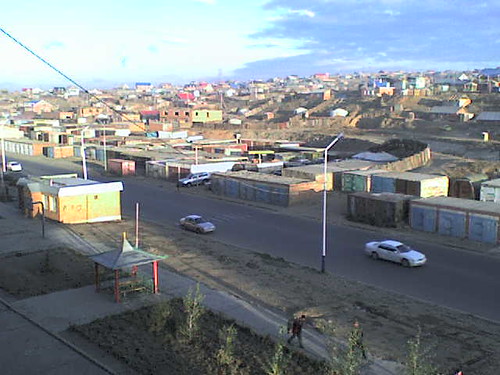Mongolia's first ever private Construction Technology College
I am working at what is reported to be Mongolia's first ever private Construction Technology College, in an effort to improve the situation for professional architectural education here. Uniquely for my long established NGO, Voluntary Service Overseas, this posting sets out to share architectural education skills, in order to create sustainable livelihoods and economic development in the rapidly changing construction industry here.
The library in this two-year old school is relatively newly established, and is an example of how different things are here. Part of the problem is the lack of available literature. Of about thirty books on the shelf dedicated to architecture, only three small A5 titles are in Mongolian. These are basic technical drawing textbooks, published about 1995. Very few of the books seem to be dated from after Mongolia's independence in 1992. About twenty of the substantial bound volumes about architecture are in Russian, and there are quite a lot of old professional journals also in Russian. There are several books and magazines in Japanese and Chinese, and none in English or German.
There is one specialist book on English for builders and architects. (Translated in 2006 by Nomuundari, Bolor and Enebish from a Russian book by Bezruchko.) There are no books on Mongolian architecture and the one Russian title on Mongolian Architecture I have seen (in a shop at the Choijin Lama Temple) is not in the school's collection.
 Fig.2 Souvenirs, State Department Store; State Circus (blue roof) through window in the distance
Fig.2 Souvenirs, State Department Store; State Circus (blue roof) through window in the distanceOur college director promises a list of new books due in the near future, but the list of titles is not available to see. There is no catalogue of the books and the librarian's computer is not attached to a network or printer. She writes the names and numbers of books loaned on the borrower's card.
One of the most potentially practical tites on the shelf is the two part handbook "Stroitelbnoe Projektirobanie" which is the Russian 1965 equivalent of a Neufert's Architect Handbook or an AJ Metric handbook. No contemporary equivalent is said to be available, but I will be interested to see what practitioners in architects offices are using for architects data.
Daily life here is not quite as clockwork as many architecture schools in the minority world where I taught previously. Classrooms have blackboards but few staff use illustrations when teaching design. There are good computer labs, the crowded computers are virus ridden. The drawing studio is full of still life pencil drawings of plaster cast heads. Most of the students here live in the peri-urban ger districts, the informal settlements where people have settled in gers (yurts) and shacks. Electricity is reticulated informally, and water comes by bucket or jerry can from wells and community tanks along unsealed roads. These areas have grown considerably in the last few years after harsh winters decimated livestock herds and many nomads moved to the city. However, the students are very keen to learn. Their practical training is like an apprenticeship and is an important part of the funding model for the private education.
 Fig.3
Fig.3
I hope to be able to achieve something helpful over the coming year and welcome readers and correspondents to my blog at http://www.nomadologist-nomadology.blogspot.com/ or via http://www.gregory.cowan.com/
Gregory Cowan
Mongolia
Architects for Peace, October 2007
--------------
See photos "walk to work": http://flickr.com/photos/nomadologist/sets/72157602236377955/





2 comments:
Thanks Beatriz for all your help with this article. The English translation for the first photo caption in Mongolian would read, "Souvenirs, State Department Store; State Circus (blue roof) through window in the distance"
You are welcome Greg. Looking forward to you article/journal from Mongolia.
Post a Comment